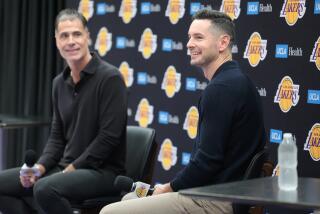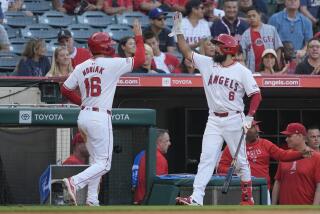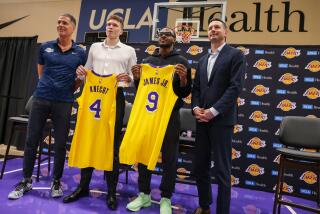Sleepers Keep NBA Scouts Awake to Draft Possibilities
- Share via
Marty Blake, the NBA’s scouting director, needed a last-minute replacement when a player backed out of the NBA’s first predraft camp in Chicago in 1982, so he phoned Tex Winter, a longtime friend who was then the coach at Cal State Long Beach.
“I’ve got a kid who lives in Chicago and can be there in five minutes,” Winter told Blake. “His name is Craig Hodges.”
For the record:
12:00 a.m. June 30, 1993 For the Record
Los Angeles Times Wednesday June 30, 1993 Home Edition Sports Part C Page 8 Column 3 Sports Desk 2 inches; 61 words Type of Material: Correction
Pro basketball--A chart in Tuesday’s editions showed Nate Archibald as a first-round selection of San Antonio in the 1970 draft. Archibald was drafted in the first round that year by the Dallas Chaparrals of the American Basketball Assn., who later became the San Antonio Spurs and eventually moved to the NBA. Archibald also was picked by the Cincinnati Royals--now the Sacramento Kings--of the NBA that year, and signed with them.
After impressing the scouts at the camp, Hodges was selected in the third round of the draft by the Clippers. He went on to play 10 years with four NBA teams, helping the Chicago Bulls win their first two NBA titles.
Hodges wasn’t the only sleeper discovered by Blake.
“It’s not hard finding players,” Blake said. “But that’s what I’m paid to do, and I’ve been doing it so long. You follow every lead. But for every player you’ve heard of, I see 50 who can’t play. So it’s just hard work.”
While scouting a Southern Mississippi player in a game against Central Arkansas, Blake couldn’t take his eyes off Central Arkansas forward Scottie Pippen, who scored 31 points.
That earned Pippen an invitation to the predraft camp, where he impressed the other scouts. Pippen was a lottery pick in the 1987 NBA draft and has become an all-star, helping the Chicago Bulls win three NBA titles and the United States to a gold medal in the 1992 Olympics.
Blake also discovered forward Dennis Rodman at Southeastern Oklahoma State, like Central Arkansas an NAIA school.
Jack McCloskey, then general manager of the Detroit Pistons, raised a few eyebrows when he selected Rodman in the second round of the 1986 NBA draft.
Although every NBA team knew of Rodman, few were willing to gamble on him, a late-bloomer who had not played high school basketball. Rodman, however, has become the NBA’s most prolific rebounder and helped the Pistons win NBA titles in 1989 and ’90.
Rodman and Pippen were perhaps the biggest sleepers in recent NBA drafts, but Blake maintains that they were sleepers only to the public.
“Sleepers is a misnomer,” Blake said. “If we can find Scottie Pippen in Conway, Ark., then there are no more sleepers.
“We’re a victim of provincialism. The people on the West Coast never heard of (Hartford forward) Vinny Baker (a potential lottery pick), and the people on the East Coast haven’t heard of (Oregon State center) Scott Haskin (projected as a first-round draft pick). So the term sleeper is relegated to the Pippens, the Rodmans, the (John) Stocktons and all those other guys I’ve discovered.”
Mitch Kupchak, assistant general manager of the Lakers, agreed.
“I think it’s possible to find a sleeper at large that the public hasn’t heard of,” he said. “But I don’t think it’s possible to find somebody that NBA scouts haven’t heard of. Scouting now is so comprehensive that there’s not a name that slips by that we or other teams don’t know of.
“Now, we might be wrong on how we project that guy or what ultimately happens with that guy, but there’s not a Scottie Pippen playing in some small town that nobody knows about. There are no hidden players that nobody knows about. Everybody knows about all the players. Only the opinions are going to be different.”
Donnie Walsh, president of the Indiana Pacers, concurred.
“There are no sleepers,” he said. “Everything I know, (Laker General Manager) Jerry West knows and (Chicago General Manager) Jerry Krause knows. There are no hidden guys out there that only one guy has located.
“Every team is doing a lot of scouting now, and they’re covering all the areas they have to cover. If you went back 10 years ago, there might have been one or two teams doing that. Others were doing half that, and some were doing very little.”
Scouting has become more sophisticated since the advent of the NBA predraft camp in Chicago, where the top prospects are evaluated by all teams, and all-star tournaments in Portsmouth, Va., and Phoenix, where lesser-known college players are evaluated.
Potential second-round selections and small-college players are invited to Portsmouth. If they’re impressive there, they’re invited to the Desert Classic in Phoenix--which replaced the Orlando Classic--and Chicago.
“Ten years ago, you had teams in this league that didn’t even have scouting staffs,” said Bob Whitsitt, Seattle SuperSonic president. “Now we all have huge scouting staffs and video services. It’s very hard to not find just about any player in the country and get every bit of information you want on him.”
Pat Williams, Orlando Magic president, not only agreed, but pointed out that because of the recent emphasis on scouting, almost no players are misdrafted these days.
“That’s why you’re seeing so few players drafted in the second round even play anymore,” he said. “We go through this screening process, and if a kid has any ability at all, he goes on the first round. Second-rounders contributing are almost nonexistent.”
Teams fly in players they are considering for predraft interviews and psychological testing.
The increased emphasis on scouting is the result of expansion and the draft’s being pared to two rounds. With more teams and only two rounds, there is less margin for error.
The draft consisted of 10 rounds from 1978 to 1985, when it was cut to seven rounds. It was further cut to three rounds in 1988, when Charlotte and Miami joined the league, then to two in 1989, when Minnesota and Orlando were brought in.
But selecting players remains an inexact science.
In 1984, for example, the Houston Rockets drafted Akeem Olajuwon and the Portland Trail Blazers selected Sam Bowie before the Chicago Bulls took Michael Jordan, who has become the NBA superstar in leading the Bulls to three consecutive titles.
Twelve teams passed on Karl Malone in the 1985 draft before the Utah Jazz selected him. Malone has become an NBA all-star. And Jeff Hornacek, who became a starter at Phoenix before going to Philadelphia in the Charles Barkley trade, was selected in the second round of the 1986 draft.
The Suns have done a good job of selecting little-known players, having drafted both Cedric Ceballos of Cal State Fullerton and Negele Knight of Dayton in the second round of the 1990 draft.
“There’s no set formula we use,” said Dick Van Arsdale, the Suns’ director of player personnel. “We’re no different than anyone else. Maybe in some cases it’s just getting a little bit lucky.”
Why is drafting so imprecise?
“We’re dealing with unknowns,” said Orlando’s Williams. “You can measure skill, but you can’t measure what’s inside a kid. You can’t measure his heart, his desire and his thinking process. That’s the thing you never know until you get a kid. You don’t know how badly he wants it and how much he’s going to work and how much he wants to improve.”
Whitsitt agreed.
“It’s not like football, where you run a play for four or five seconds and you get a minute to rest,” he said. “You can measure certain things physically, but you can’t totally measure the ability to read situations and read plays. You can’t exactly read how they’re going to fit in with your situation and play with your players. You can’t read how they’re going to get along in your locker room.
“You can’t absolutely tell what happens after you give them millions of dollars before they go to work, and you can’t tell how they’re going to respond to media hype and fan pressure.
“It’s not an exact science because you’re dealing with people.”
Who will be the sleepers in the 1993 NBA draft?
Lindsey Hunter, a 6-foot-1 point guard from Jackson State in Mississippi, and 6-10 forward Baker of Hartford, who were impressive at the NBA predraft camp, are probable first-round picks, as is 7-7 center Gheorghe Muresan of Romania, who is playing in France. The Lakers might take Hunter, if he is available.
“Hunter was the best player at our camp in Chicago,” Blake said. “He’s got great quickness and can shoot well, and he’s intense.”
John Nash, general manager of the Washington Bullets, is also high on Hunter.
“He didn’t play in a high-visibility program, but he’s got a lot of talent,” Nash said. “He’s got outstanding scoring ability and quickness and point-guard skills that make him a top prospect.”
Bryon Russell, a 6-7 forward from Long Beach; Rich Manning, a 6-10 center from Washington, and UCLA’s Mitchell Butler also impressed the scouts at the NBA predraft camp.
Some lesser-known players who made big impressions and will probably be drafted include Darnell Mee, a 6-3 guard from Western Kentucky; Leonard White, a 6-7 forward from Southern; Sherron Mills, a 6-8 forward from Virginia Commonwealth; Jay Goodman, a 5-11 point guard from Utah State, and Alphonso Ford, a 6-1 guard from Mississippi Valley State.
Several scouts were also impressed with Etienne Preira, a 6-5 swing man from Senegal. But Preira, who had hoped to play at Georgetown but didn’t qualify academically, is a viewed as a project who probably won’t be drafted.
“If you picked him, or brought him in as a free agent, and he set the world on fire, then someone would say later, ‘That general manager is a genius and maybe the kid needed time to develop,’ ” Van Arsdale said.
“A lot of times, it’s not so much seeing the talent as trying to figure out how he’s going to develop in the next few years, because some of those sleepers need a little time.”
Charting the First-Round Picks
A look at the best and worst of the previous first rounds of the NBA draft. Information compiled by Houston Mitchell of The Times:
THE BEST
The first rounds of 1962, 1984 and 1970 produced the best players with the most longevity. Honorable mention goes to the 1960 draft, which produced Jerry West and Oscar Robertson, but little else.
1962
Team: St. Louis Player: Zelmo Beatty Pos: C Comment: Averaged 17.5 points, 11 rebounds in 14 seasons. Team: Boston Player: John Havlicek Pos: G-F Comment: Member on eight championship teams. Hall of Famer. Team: Detroit Pistons Player: Dave DeBusschere Pos: F Comment: On all-defensive team six times. Hall of Famer. Team: San Francisco Player: Wayne Hightower Pos: F-C Comment: Averaged 10.8 points, 7.6 rebounds in 11 seasons. Team: Lakers Player: LeRoy Ellis Pos: C Comment: Member of the 1972 Laker championship team. Team: New York Player: Paul Hogue Pos: C Comment: Every draft has to have a guy like this. Team: Cincinnati Player: Jerry Lucas Pos: F-C Comment: Seven-time all-star. Hall of Famer Team: Chicago Player: Billy McGill Pos: C-F Comment: Averaged 10 points in five seasons.
1984 (Note: Denver, Golden State, New York and Seattle did not have first-round picks) Team: Atlanta Player: Kevin Willis Pos: F-C Comment: Has averaged 13.3 points in nine seasons. Team: Boston Player: Michael Young Pos: F Comment: Played three seasons. Team: Chicago Player: Michael Jordan Pos: G Comment: Never heard of him. Team: Cleveland Player: Tim McCormick Pos: C Comment: Has averaged 8.3 points, 4.9 rebounds. Team: Dallas Player: Sam Perkins Pos: F Comment: All-rookie team. Has averaged 14.5 points. Team: Dallas Player: Terence Stansbury Pos: G Comment: Played three seasons. Team: Detroit Player: Tony Campbell Pos: F Comment: Has averaged 13.3 points. Team: Houston Player: Hakeem Olajuwon Pos: C Comment: All-rookie team. Seven-time all-star. Team: Indiana Player: Vern Fleming Pos: G Comment: Has averaged 13 points in nine seasons. Team: Clippers Player: Lancaster Gordon Pos: G Comment: Averaged 5.6 points in four seasons. Team: Clippers Player: Michael Cage Pos: F Comment: Led NBA in rebounding in 1988. Team: Lakers Player: Earl Jones Pos: C Comment: Played 14 games in the NBA. Team: Milwaukee Player: Kenny Fields Pos: F Comment: Played four seasons. Wound up with Clippers. Team: New Jersey Player: Jeff Turner Pos: F Comment: Now a reserve for Orlando. Team: Philadelphia Player: Charles Barkley Pos: F Comment: 1993 MVP. Seven-time all-star. No role model. Team: Philadelphia Player: Leon Wood Pos: G Comment: Played seven seasons mainly off the bench. Team: Philadelphia Player: Tom Sewell Pos: G Comment: Played only 21 games in the NBA. Team: Phoenix Player: Jay Humphries Pos: G Comment: Has averaged 12.2 points. Team: Portland Player: Sam Bowie Pos: C Comment: Picked ahead of Jordan in draft. Team: Portland Player: Bernard Thompson Pos: F Comment: Played five seasons. Team: Sacramento Player: Otis Thorpe Pos: F Comment: Has averaged 16.4 points. Team: San Antonio Player: Alvin Robertson Pos: G Comment: On all-NBA defensive team six times. Team: Utah Player: John Stockton Pos: G Comment: Has led NBA in assists six consecutive years. Team: Washington Player: Mel Turpin Pos: C Comment: Best known for nickname “Dinner Bell.”
1970 (Note: San Francisco did not have a first-round pick.)
Team: Atlanta Player: Pete Maravich Pos: G Comment: Averaged 24.2 points over 10 seasons. Hall of Famer. Team: Atlanta Player: John Vallely Pos: G Comment: Not quite as successful as Pistol Pete. Team: Boston Player: Dave Cowens Pos: C Comment: MVP in 1973. Seven-time all-star. Hall of Famer. Team: Chicago Player: Jimmy Collins Pos: G Comment: Played two seasons. Team: Cincinnati Player: Sam Lacey Pos: C Comment: Played 13 seasons. Averaged 9.7 rebounds. Team: Cleveland Player: John Johnson Pos: F Comment: Averaged 15.1 points over 12 seasons. Team: Denver Player: Spencer Haywood Pos: F Comment: Averaged 19.2 points over 12 seasons. Team: Detroit Player: Bob Lanier Pos: C Comment: First pick of draft. Nine-time All-Star. Hall of Famer. Team: Indiana Player: Rick Mount Pos: G Comment: Six seasons in the NBA. Team: Buffalo Braves Player: John Hummer Pos: F Comment: Had something to fall back on--Princeton education. Team: Lakers Player: Jim McMillian Pos: F Comment: Averaged 15.2 points over nine seasons. Team: Milwaukee Player: Gary Freeman Pos: F Comment: Played a very unmemorable one season. Team: New York Player: Mike Price Pos: G Comment: Played three seasons. Team: Philadelphia Player: Al Henry Pos: C Comment: Played two seasons. Team: Phoenix Player: Greg Howard Pos: F Comment: Played two seasons. Team: Portland Player: Geoff Petrie Pos: G Comment: Averaged 21.8 points per game over seven seasons. Team: San Antonio Player: Nate Archibald* Pos: G Comment: Six-time all-star. Ninth in assists all time. Team: San Diego Player: Rudy Tomjanovich Pos: F Comment: Played 11 seasons, averaged 15.6 points. Team: Seattle Player: Jim Ard Pos: F-C Comment: Role player for eight seasons. Team: Washington Player: George Johnson Pos: C Comment: Played four seasons.
THE WORST
1990
Team Player Pos. Atlanta Rumeal Robinson G Boston Dee Brown G Charlotte Kendall Gill G Denver Chris Jackson G Detroit Lance Blanks G Golden State Tyrone Hill F Houston Alec Kessler F-C Clippers Bo Kimble G Clippers Loy Vaught F Lakers Elden Campbell F Miami Willie Burton G Miami Dave Jamerson G Milwaukee Terry Mills F Minnesota Felton Spencer C Minnesota Gerald Glass G New Jersey Derrick Coleman F New Jersey Tate George G New York Jerrod Mustaf F Orlando Dennis Scott C Phoenix Jayson Williams F Portland Alaa Abdelnaby F Sacramento Lionel Simmons F Sacramento Travis Mays G Sacramento Duane Causwell C Sacramento Anthony Bonner F San Antonio Dwayne Schintzius C Seattle Gary Payton G
The only draft without a real impact player. Derrick Coleman and a supporting cast of extras.
Note: Chicago, Cleveland, Dallas, Indiana, Philadelphia, Utah, Washington did not have first-round picks.
More to Read
Go beyond the scoreboard
Get the latest on L.A.'s teams in the daily Sports Report newsletter.
You may occasionally receive promotional content from the Los Angeles Times.










